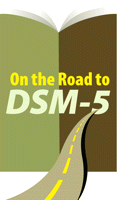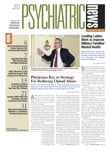In February 2010, APA and the
DSM-5 leadership gave the public a first look at potential changes for the upcoming fifth edition of the
Diagnostic and Statistical Manual of Mental Disorders (DSM-5). With the launching of the <
www.dsm5.org> Web site, visitors learned about proposed draft diagnostic criteria, how those proposed changes compared with current criteria in
DSM-IV, and the rationale for these suggested changes. The site is also home to a wide variety of relevant background information about the development of
DSM-5, such as its task force and work group members and updates on concurrent development activities, such as recent
DSM-5-related publications and presentations.
This month, we launched a revised
DSM-5 Web site that represents some important changes from the original site posted more than a year ago (see
DSM-5 Web Site: Check It Out). Visitors to the new site may immediately notice a change in the organizational structure of how disorders are grouped. Rather than being organized to parallel the chapter structure of
DSM-IV, the new site reflects the proposed organizational structure for
DSM-5. While the two are largely similar, there are some noteworthy differences. For instance, rather than collectively grouping all childhood and adolescent disorders into one chapter, these diagnoses are distributed throughout
DSM-5 into the relevant diagnostic sections. Visitors can now read about pica under the category "Eating and Feeding Disorders," for example. Similarly, trauma- and stress-related disorders, such as posttraumatic stress disorder and adjustment disorders, are now a distinct category rather than being housed under anxiety disorders, as in
DSM-IV.The revised organizational structure of diagnoses is not the only change. Nearly all of the disorder proposals have been refined in one way or another since last February. While many contain only minor changes to wording, others include more significant changes to criteria. For instance, the Sleep-Wake Disorders Work Group revised the criteria for primary insomnia to better address variations in symptomatology across the lifespan. Readers may notice that the newly proposed mild and major neurocognitive disorders each now include criteria for a subtype to account for traumatic brain injury as an etiology. And autism spectrum disorder has been revised to include severity measures and has improved clarity by including examples among the criteria.
The new DSM-5 Web site also includes a detailed section on field trials that was not present on the original site. Within the content posted here is information about the purpose and design of the field trials, detailed protocols from each of the two main types of field trials being conducted, and descriptions of where field testing is taking place. Throughout the past 14 months, we have also continued to update media content, the DSM-5 timeline, relevant lists of DSM publications and presentations, and more. A detailed listing of all changes that have occurred to the site over the past year is provided.
As with the February 2010 release, this second release of the Web site features a comment period in which we welcome professionals and the public to submit feedback about our proposals. In the first six weeks following release of the new site, which was launched May 4, visitors can once again send the work groups questions and considerations about draft changes until June 15. Work group members will review all comments and determine whether additional changes in proposals are needed.
Although we initially planned two commenting periods—the first in 2010 and another following the completion of the field trials—we believe the changes represented on the new DSM-5 Web site are sufficient enough to warrant public comment. Alterations in diagnostic criteria, dimensional assessments, and the organizational structure may potentially impact how clinicians and researchers use DSM-5, which means patients and their family members may be equally likely to feel the effects of these proposals.
A third period of public posting will take place after the field trials have concluded. At that time, draft criteria will be revised based on both submissions to the Web site during this comment period and findings from field tests. In fact, visitors to the site should be aware that the diagnostic criteria as currently posted will not change until after the field trials are completed. In short, this commenting period does not represent the final opportunity for those individuals who are interested to voice their opinions on proposed DSM-5 revisions.
Our previous period of public feedback yielded more than 8,000 questions and suggestions from patients, family members, advocates, clinicians, and researchers, and while we do not expect the same volume of responses during this comment period, we are optimistic that the public will once again share with us their invaluable perspective on DSM-5. We look forward to hearing from you during this time.
Footnotes
David J. Kupfer, M.D., is chair of the DSM-5 Task Force and a professor of psychiatry at University of Pittsburgh Medical Center and Western Psychiatric Institute and Clinic.

